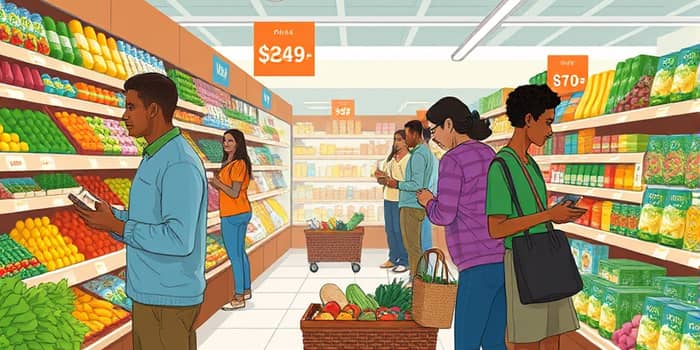
As households around the globe adjust their budgets in response to rising grocery bills, the structure and profitability of the supermarket industry are undergoing a profound transformation. From bustling urban markets to rural outlets, grocers and consumers alike are navigating an era defined by unprecedented price volatility.
The global food consumer price index climbed dramatically from 2.7% in 2019 to 10.1% in 2022, driven by pandemic-related supply chain disruptions and surging commodity costs. By 2023, food inflation eased to 8.3%, then fell sharply to 3.3% in 2024, yet remained elevated above pre-pandemic norms.
Regional imbalances persist. In the European Union, food inflation spiked to 19.2% in March 2023 before moderating to 1.86% by April 2024. North America saw more modest rises: U.S. grocery prices rose 2.9% year-on-year in May 2025, while Canada’s 11.4% surge in September 2022 marked its steepest increase since 1981.
Developing nations face more acute challenges. Over 76% of low-income countries and 54.5% of lower-middle-income countries reported food price inflation exceeding 5% as of early 2025, often outpacing overall inflation and straining household finances.
Consumers are altering their shopping habits under pressure from shrinking real incomes and squeezed budgets. Two-thirds of shoppers say they spent significantly more on groceries in the past quarter compared to the same period last year, and nearly 60% report that food now consumes a larger share of their income.
These shifts fueled double-digit growth during the pandemic for many retailers, but 2023 brought flatter performance as inflation tempered discretionary purchases and intensified competition among grocers.
Producers grappled with escalating input costs. Canadian farmers, for example, saw operating expenses jump 16.1% due to higher feed, fuel, and fertilizer prices. Globally, transport bottlenecks and labor shortages further inflated distribution costs, compelling food processors to absorb or pass on these increases.
Profit margins in the grocery sector have remained surprisingly resilient. Revenues for food and beverage retailers outpaced costs by over 6% in 2021 and reached 7% by 2023, reflecting both strategic price increases and cost-control measures.
Underlying grocery costs are shaped by volatile commodity markets. Since May 2025, agricultural price indices dipped 1%, with maize and rice prices falling by 4% and 1% respectively, while wheat prices rose 3%. Year-on-year, maize is 2% lower, wheat 20% lower, and rice 31% lower than in May 2024.
Despite recent moderations, commodity costs remain high compared to early 2020, emphasizing the need for grocers to hedge risks and secure stable supply arrangements.
Political and regulatory scrutiny of grocery pricing has intensified. Authorities like the U.S. Federal Trade Commission have launched inquiries into potential price gouging, and policymakers from the White House to the Senate have pressed for greater transparency in pricing practices.
Looking forward, several factors will shape the sector’s trajectory:
However, persistent geopolitical tensions, climate-related crop disruptions, and labor market challenges could reignite volatility in raw material costs, keeping grocers on edge.
In response, retailers are doubling down on innovation: integrating AI for demand forecasting, expanding omnichannel options, and cultivating closer partnerships with local producers to ensure both affordability and resilience.
Ultimately, the grocery sector’s ability to adapt to volatile food price environments will determine its performance in the years ahead. By blending strategic pricing, operational efficiency, and consumer-centric offerings, grocers can navigate the complexities of food inflation while maintaining strong relationships with shoppers.
References













